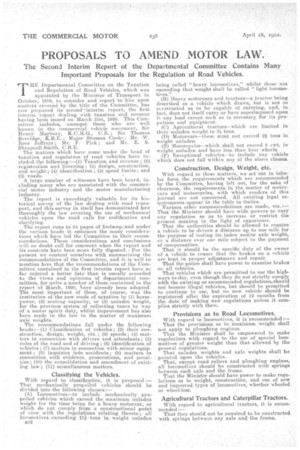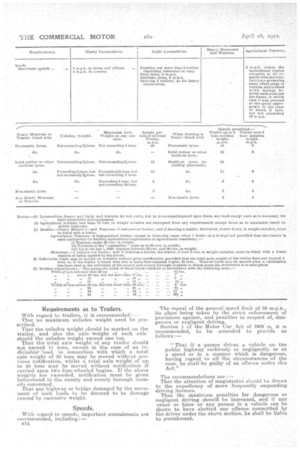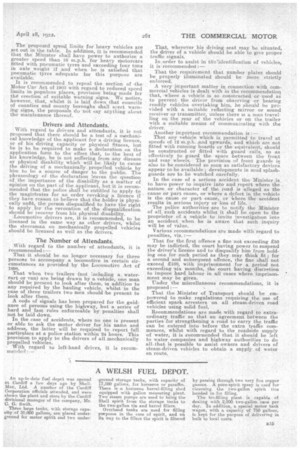PROPOSALS TO AMEND MOTOR LAW.
Page 12

Page 13

Page 14

Page 15

If you've noticed an error in this article please click here to report it so we can fix it.
The Second Interim Report of the Departmental Committee Contains Many Important Proposals for the Regulation of Road Vehicles.
THE Departmental Committee. on the Taxation and Regulation of Road Vehicles, which was appointed by the Minister of Transport in October, 1919, to consider and report to him upon matters coveeed by the title of the Committee, has now prepared its second 'interim report, the first interim 'report dealing with taxation and revenue having been issued on March 31st, 1920. This Committee includes, amongst those who are well known in the commercial vehicle movement, Sir Henry Maybury, K.C.M.G., C.B. ; Sir Thomas Berridge, K.B.E.Major Stenson Cooke ; Mr. W. Bees Jeffreys ; Mr. F. • Pick ; and Mr. E. S. Shrapnell-Smith, C.B.E. The matters whichhave come under the head Of taxation and regulation of road vehicles have included, the following :—(1) Taxation and revenue ;. (2) registration and 'licensing ; (3) design, construction, and weight ; (4) identification; (6) speed limits; and
(e) r oad s. A large number of witnesses have been heard, including many who are associated with the commercial motor industry and the motor manufacturing industry. The report is exceedingly valuable for its historical survey of the law dealing with road transport, and this survey in itself has demonstrated how thoroughly the law covering the use of mechanical vehicles upon the road calls for codification and clarifying.
The report runs to 84 pages of foolscap, and under the various heads it embraces the many considerations which have led the Committee to their recommendations. These considerations and conclusions will no doubt call for comment when the report and its contents have been more fully digested. 'For the present we content ourselves with summarizing the recommendations of the Committee, and it is well to mention here that the recommendations of the Coine mittee contained in the first interim report have se far enjoyed a better fate than is usually accorded to the views and opinions of departmental committees, for quite a number of those contained in the report of March. 1920, have already been adopted. The most important of these, of course, was the institution of the new mode of takation by (1) horsepower, (2) -seating capacity, or (3) unladen Weight, for the previous system of collecting taxes by way of a mnotor spirit duty, whilst improvement has also been made in the law in the matter of maximum axle weights.
The recommendations fall under the following heads:—(1) Classification of vehicles; (2) their construction, design, weight, etc. ; (3) speeds; (4) matters in connection with drivers and attendants; (5) rules of the road and of driving ; (6) identification of vehicles ; (7) matters in connection with minor equipment; (B) inquiries into accidents; (9) matters in connection with evidence, prosecutions, and penalties; (10) the consolidation and amendment of existing law; (11) miscellaneous matters.
Classifying the Vehicles. .
'With regard to classification, it is proposed:— That mechanically propelled vehicles should be divided into the following clauses:—
(A) Locomotives—to include mechanically propelled vehicles which exceed the maximum unladen weight for the time being for a heavy motorcar, or which do not comply from a constructional point of view with the regulations relating thereto ; all locomotives-exceeding 11 tons in weight unladen being called "heavy locomotives," whilst these. not exceeding that weight shall be called "light locomotives."
(B) Heavy motorcars and tractors—a tractor, being described as a vehicle which draws, but is not FO ectstrueted as to he capable of carrying, and, in fact., does not itself carry or have superimposed upon it any load except such as is necessary for its propulsion and equipment.
(0) Agricultural tractors—which are limited in their unladen weight to 3i tons. (f)) Motorcars—these must not exceed 2-i tons in weight unladen. (E) Alotoreveles—which shall not exceed 8 ewt. in weight unladen and have less than •four wheels. (F) xeeptional vehicles—to include any vehicle which does not fall within any of the above classes.
Construction, Design, Weight, etc.
With regard to these matters, we set out in tabular form the requirements which are recommended by the Committee, having left out, for the sake of clearness, the requirements in the matter of motorears and motorcycles„ with which readers of this journal are not concerned. All existing legal requirements appear in the table in italics. Various other recommendations are made, viz.:— That the Minister should have wide powers to vary any regulation so as to increase or restrict the present maxima in the light of experience. That the authorities should be allowed to require a vehicle to be driven a distance up to one mile for the purpose of testing its laden and/or axle weight, or a distance over one mile subject to the payment of compensation. That it should be the specific duty of the owner of a vehicle to ensure that the brakes on a vehicle are kept in proper adjustment and repair. That the police shall have power to examine brakes on all vehicles.
That vehicles which are permitted to use the highways to-day, even though they do not strictly comply with the existing or recommended regulations, should not become illegal vehicles, but should he permitted to continue in use, but no new vehicle should be registered after the expiration of 12 months from the date of making new regulations unless it complies strictly with them.
Provisions as to Road Locomotives.
With regard to locomotives, it is recommended:— That the provisions as to maxinium weight shall not apply to ploughing engines.
That the Minister Shall be empowered to make regulations with regard to the -use of special locomotives of greater weight than that allowed by the general regulations.
That unlad.en weights and axle weights shall be painted upon the vehicles. .
That, except road rollers and ploughing engines, all locomotives should he constructed -with springs between each axle and the frame.
That the Minister should have power to make regulations as to weight, construction, and use of new and improved types of locomotives, whether wheeled or wheel-less.
Agricultural Tractors and Caterpillar Tractors.
'With regard to agricultural tractors, it is recommended:— That they should not be required to be constructed with springs between any axle and the frame. That, on tractors drawing agricultural machinery, only one identification plate should be required to be fixed in front.
That tractors of the caterpillar type should be legalized for the same purpose as wheeled agricultural tractors.
That the minimum width or diameter of the track
in contact with the ground should be. in., and the total area of track in contact to be not less than 36 sq. ins, per ton of unladen weight.
That agricultural tractors not exceeding 10 cwt. in unladen weight shall be exempt from any regulations as to construction and use, except as to speed when on the highway.
Requirements as to Trailers.
With regard to trailers, it is recommended :— That no maximum unladen weight need be prescribed.
That the unladen weight should be ma,rketi on the trailer, and also the axle 'weight of each axle shoulcethe unladen weight exceed one ton.
That the total axle weight of any trailer should not exceed 14 tons, except in the ease of an indivisible load, in connection with which a total axle weight of 20 tons May be moved without previous notification, whilst a total axle weight of up to 28 tons may be moved without notification if carriedupon two four-wheeled bogies. If the above weights are exceeded, notification must be given beforehand to the county and county borough councils concerned.
That any highway or bridge damaged by the movement of such loads to be deemed to be damage caused by excessiveweight.
Speeds.
With regard to speeds, important amenclments are recommended, including :— B14
The repeal of the general speed limit of 20 m.p.h., its place being taken by the strict enforcement of provisions against, and penalties in respect of, dangerous or negligent driving.
Section 1 of the Motor Car Act of 1903 is. it is recommended, to be amended to provide as follows:— "That if a person drives a vehicle on the public highway recklessly or negligently or at a speed or in a manner which is dangerous, having regard to all the circumstances of the case, he shall he guilty of an offence under this Act."
The recommendations are:— .
That the attention of magistrates should be drawn to the expediency of more frequently suspending driving licences. That the maximum penalties for dangerous or negligent driving should be increased, and if any Dwner or hirer or any -person in a vehicle can be shown to have abetted any offence committed by the driver under the above section, he shall be liable to punishment.
The proposed speed limits for heavy vehicles are set out in the table. In addition, it is recommended that the Minister shall have power to authorize a greater speed than 16. m.p.h. for heavy Motorcars fitted with pneumatic tyres and exceeding four tons in axle weight if and when he is satisfied that pneumatic tyres adequate for this purpose are available.
It is recommended to repeal the section of -the. Motor Car Act of 1903 with regard to reduced speed limits in populous places, provision being made for the erection of suitable warning signs. We notice, however, that, whilst it is laid down that councils of counties and county boroughs shall erect warning signs, the proposals do 'not say anything about the maintenance thereof.
Drivers and Attendants.
'With regard to drivers and attendants, it is not proposed that there should be a test of a mechanical knowledge of the applicant for a driving licence, or of his driving capacity or physical fitness, but he is to be required to make a declaration on the application form to the effect that, to the best of his knowledge, he is not suffering from any disease or physical disability which will be likely to cause the driving of a mechanically .propelled vehicle by him to be a source of danger to the public. The phraseology of the declaration !eaves the question of the importance of the disability as a matter of opinion on the part elthe applicant, but it is recommended that the police shall be entitled to. apply to the magistrates for an order revoking a licence if they have reason to believe that the holder is physically unfit, the person disqualified to have the right to apply for the revocation of the disqualification should he 'recover from his physical disability.
.Locomotive drivers are, it is recommended, to be licensed in the same way as other drivers, whilst the steersman on mechanically propelled vehicles should be licensed as well as the drivers.
The Number of Attendants.
With regard to the number of attendants, it is recommended:— That it should be no longer necessary for three persons to accompany a locomotive in certain circumstances as provided by the Locomotive Act of 1898.
That when two trailers (not . including a watercart or van) are being drawn by a vehicle, one man should be present to look after them, in addition to any required by the hauling vehicle, whilst in the case of three trailers two men should be present to look after them.
A code of signals has been prepared for the guidance of persons using the highway, but a series of hard and fast rules enforceable by penalties shall not be laid down.
In the case of accidents, where no one is present or able to ask the motor driver for his name and address the latter will be required to report full particulars at a police station within-24 hours. This provision to apply to -the drivers of all, mechanically propelled vehicles..
With regard to left-hand drives, it is recomthended: That, wherever his driving seat may he situated, the driver of a vehicle should be able to give proper traffic signals.
In order to assist in the!identification of vehicles, it is' recommended : That the requirement that number plates should be properly illuminated should be more strictly enforced, A very important matter in connection with commercial vehicles is dealt with in the recommendation that, where a vehicle is so constructed or used as to prevent the driver from observing or hearing readily vehicles overtaking him, he shotild be provided with a. Suitable reflecting mirror or sound receiver or transmitter, unless there is a man travelling on the rear of the vehicles or' on the trailer with a suitable means of communicating with the driver.
Another important recommendation is:—
That any vehicle which is permitted to travel at speeds of 12 m.p.h. ,and upwards, and which are not fitted with running boards or the equivalent, should be constructed or fitted with guard rails, so as effectively to guard the space between the front and rear wheels. The provision of front guards is also to be considered so soon as satisfactory devices appear to be available ; developments in mud splashguards are to be watched carefully.
In the case of a serions accident the Minister is to have power to inquire into and report where the nature or character of the road is alleged as the cause or part cause, or where a defect in the vehicle is the cause or part cause, or where the accident results in serious injury or loss of life.
The police authorities are to notify the Minister of all such accidents whilst it shall be open to the proprietor, of a vehicle to invite investigation into an accident when he is aware that such inquiry will be of value.
Various recommendations are made with regard to penalties, viz, :—
That for the first offence a fine not exceeding £50 may be inflicted, the court having power to suspend the driver's licence and to disqualify him from holding one for such period as they may think fit • for a second and subsequent offence' the fine shall not exceed 2100, with imprisonment for a period not exceeding -six months, the court having .discretion to impose hard labour in all cases where imprisonment may be given.
Under the miscellaneous recommendations, it is proposed:— That the Minister of Transport should be empowered to make regulations requiring the use of efficient spark arresters on all steam-driven road vehicles using solid fuel.
Recommendations are made with regard to extraordinary traffic so that an agreement between the parties forstrengthening a road to carry the traffic can be entered into before the extra traffic commences, whilst with regard to the roadside supply of water, it is *recommended that it should be left to water companies and highway authorities to do all-that is possible to assist owners and drivers of steam-driven vehicles to obtain a supply of water en route.


































